| Article ID | Journal | Published Year | Pages | File Type |
|---|---|---|---|---|
| 8489214 | Animal Behaviour | 2016 | 7 Pages |
Abstract
Warblers regularly give flight calls during migration, but few studies have addressed flight-calling behaviour by individual birds. In this study, we investigated individual responses to flight calls. We hypothesized that birds would be more likely to give flight calls in response to conspecific flight calls than to heterospecific calls or to other sounds. We studied the flight-calling response of three species of warblers (magnolia warbler, Setophaga magnolia, blackpoll warbler, Setophaga striata, and yellow-rumped warbler, Setophaga coronata) to conspecific calls, calls of one of the other two species or calls of the spring peeper, Pseudacris crucifer, as a control. Additionally, we characterized the proportion of birds calling and the rates of calling (calls/min) for five additional warbler species. We placed each bird individually into an acoustic cone in a soundproof recording studio and recorded its vocalizations before, during and after playing sound cues in the studio. In our experiment, the three species of warblers were more likely to give flight calls in response to flight calls than to the control, and they were more likely to give flight calls to conspecific calls than heterospecific calls. The eight species of warblers that heard conspecific flight calls varied in both the likelihood of giving a response and the rate of calling, and rates of calling also varied between individuals within each species. Most birds that responded gave flight calls soon after hearing flight calls. Our results are some of the first on individual flight-calling responses and flight-calling rates.
Keywords
Related Topics
Life Sciences
Agricultural and Biological Sciences
Animal Science and Zoology
Authors
Sara R. Morris, Kyle G. Horton, Amy K. Tegeler, Michael Lanzone,
